Optimizing Operating Parameters of High-Temperature Steam for Disinfecting Total Nematodes and Bacteria in Soil: Application of the Box−Behnken Design
Abstract
1. Introduction
2. Materials and Methods
2.1. Soil Sterilization and Sampling
2.2. Calculation of the Removal Efficiency of Total Nematodes and Total Bacteria
2.3. Measurement of Energy Consumption
2.4. Selection of Target Parameters for Optimization
2.5. Response Surface Methodology and Box–Behnken Design
2.6. Steps for Parameter Optimization
- Step 1. Observe the temperature changes of the soil according to the level of the three explanatory variables. In the BBD, the range of each variable should include the changing point at which the result begins to increase or decrease. Therefore, if the range of each variable does not include a changing point at which the degree of increase in the soil temperature begins to decrease, reset the range of the variables. If the range includes the changing point, set three levels of these variables for performing the BBD. These pre-experiments were performed sequentially by dividing the same greenhouse of 400 m2 into four parts. Temperatures of 9 cm, 12 cm, and 15 cm depth under the soil were measured simultaneously at five-minute intervals using digital thermometers (model CS-101, ACUBA, Seoul, Korea).
- Step 2. Conduct the BBD experiments and calculate the removal efficiency of nematodes and total bacteria, and the amount of light oil used for soil disinfection.
- Step 3. Conduct the RSM simulation and analysis of variance (ANOVA) and estimate quadratic equations for the variables.
- Step 4. Investigate the optimal conditions for the explanatory variables based on the contour graph and surface plots produced from the RSM simulations. The desirability values which represent the closeness of a response to its ideal value are calculated using the desirability function provided by Minitab software [22].
3. Results
3.1. Setting Ranges for the Explanatory Variables through Basic Experiments
3.2. BBD Experiments and Regression Models
3.3. Response Surface and Contour Plot Analysis
3.4. Optimization of the Sterilization Operation Parameters
4. Discussion
5. Conclusions
Supplementary Materials
Author Contributions
Funding
Conflicts of Interest
References
- Momma, N.; Kobara, Y.; Uematsu, S.; Kita, N.; Shinmura, A. Development of biological soil disinfestations in Japan. Appl. Microbiol. Biotechnol. 2013, 97, 3801–3809. [Google Scholar] [CrossRef]
- Taylor, A.L.; Sasser, J.N. Biology, Identification and Control of Root-Knot Nematodes (Meloidogyne Species); North Carolina State University Graphics: Raleigh, NC, USA, 1978. [Google Scholar]
- RDA. Distrubution and Occurrence of Root-Knot Nematodes under Greenhouse Cultivation; Rural Development Administration: Seoul, Korea, 2016. [Google Scholar]
- Shurtleff, M.C.; Averre, C.W. Diagnosing Plant Diseases Caused by Nematodes; APS Press: St Paul, MN, USA, 2000. [Google Scholar]
- RDA. Study on Occurrence and Damage to Disease and Pest of Crops by Climate Changes; Rural Development Administration: Seoul, Korea, 2014. [Google Scholar]
- UNEP. 2010 Report of the Methyl Bromide Technical Options Committee; United Nations Environmental Programme: Nairobi, Kenya, 2010. [Google Scholar]
- Chrustek, A.; Hołyńska-Iwan, I.; Dziembowska, I.; Bogusiewicz, J.; Wróblewski, M.; Cwynar, A.; Olszewska-Słonina, D. Current Research on the Safety of Pyrethroids Used as Insecticides. Medicina (Kaunas) 2018, 54, 61. [Google Scholar] [CrossRef] [PubMed]
- UNEP. 1998 Report of the Methyl Bromide Technical Options Committee; United Nations Environmental Programme: Nairobi, Kenya, 1998. [Google Scholar]
- Baker, K.F. Principles of heat treatment of soil and planting material. J. Aust. Inst. Agr. Sci. 1962, 28, 118–126. [Google Scholar]
- Runia, W.T.; Molendijk, L.P.G. Physical methods for soil disinfestation in intensive agriculture: Old methods and new approaches. Acta Hortic. 2010, 883, 249–258. [Google Scholar] [CrossRef]
- Holmes, G.J.; Mansouripour, S.M.; Hewavitharana, S.S. Strawberries at the Crossroads: Management of Soilborne Diseases in California Without Methyl Bromide. Phytopathology 2020, 110, 956–968. [Google Scholar] [CrossRef] [PubMed]
- Lee, Y.K. The Study on the Soil Temperature Heated by Steam Injection of the Steam Soil Sterilizer. Master Thesis, Yeungnam University, Gyeongsangbuk-do, Korea, 2014. [Google Scholar]
- Paek, D.; Koh, Y.; Park, D.-U.; Cheong, H.-K.; Do, K.-H.; Lim, C.-M.; Hong, S.-J.; Kim, Y.-H.; Leem, J.-H.; Chung, K.H.; et al. Nationwide study of humidifier disinfectant lung injury in South Korea, 1994–2011. Incidence and dose–response relationships. Ann. Am. Thorac. Soc. 2015, 12, 1813–1821. [Google Scholar] [CrossRef]
- Jang, I.H. Evaluation of Damage Caused by Root-Knot Nematode in Eggplant and the Effect of High Temperature Steam Treatment on Nematode Growth. Master Thesis, Catholic University, Seoul, Korea, 2010. [Google Scholar]
- Viglierchio, D.R.; Schmitt, R.V. On the methodology of nematode extraction from field samples: Baermann funnel modifications. J. Nematol. 1983, 15, 438–444. [Google Scholar]
- Cappuccino, J.G.; Welsh, C.T. Microbiology: A Laboratory Manual, Global Edition; Benjamin-Cummings Publishing Company: New York, NY, USA, 2017; p. 477. [Google Scholar]
- Tong, L.-I.; Chang, Y.-C.; Lin, S.-H. Determining the optimal re-sampling strategy for a classification model with imbalanced data using design of experiments and response surface methodologies. Expert Syst. Appl. 2011, 38, 4222–4227. [Google Scholar] [CrossRef]
- Khuri, A.I. Response Surface Methodology and Related Topics; World Scientific Publishing Co.: Hackensack, NJ, USA, 2006. [Google Scholar]
- Montgomery, D.C. Design and Analysis of Experiments, 6th ed.; John Wiley & Sons: Hoboken, NJ, USA, 2002. [Google Scholar]
- Prakash Maran, J.; Sivakumar, V.; Sridhar, R.; Prince Immanuel, V. Development of model for mechanical properties of tapioca starch based edible films. Ind. Crops Prod. 2013, 42, 159–168. [Google Scholar] [CrossRef]
- Ragonese, R.; Macka, M.; Hughes, J.; Petocz, P. The use of the Box–Behnken experimental design in the optimisation and robustness testing of a capillary electrophoresis method for the analysis of ethambutol hydrochloride in a pharmaceutical formulation. J. Pharm Biomed. Anal. 2002, 27, 995–1007. [Google Scholar] [CrossRef]
- Harrington, E.C. The desirability function. Ind. Qual. Control 1965, 21, 494–498. [Google Scholar]
- Pimentel, D.; Burgess, M. Environmental and economic costs of the application of pesticides primarily in the United States. In Integrated Pest Management: Pesticide Problems; Pimentel, D., Peshin, R., Eds.; Springer: Dordrecht, The Netherlands, 2014; Volume 3, pp. 47–71. [Google Scholar]
- Navarro, S.; Vela, N.; Navarro, G. An overview on the environmental behavior of pesticide residues in soils. Span. J. Agric. Res. 2007, 5, 357–375. [Google Scholar] [CrossRef]
- Frank, M.P.; Graebing, P.; Chib, J.S. Effect of soil moisture and sample depth on pesticide photolysis. J. Agric. Food Chem. 2002, 50, 2607–2614. [Google Scholar] [CrossRef]
- Sonia Rodríguez-Cruz, M.; Jones, J.E.; Bending, G.D. Field-scale study of the variability in pesticide biodegradation with soil depth and its relationship with soil characteristics. Soil Biol. Biochem. 2006, 38, 2910–2918. [Google Scholar] [CrossRef]
- Tateya, A. Japan’s Big Effort to Phase-out of Methyl Bromide by 2013; International Society for Horticultural Science (ISHS): Leuven, Belgium, 2010; pp. 83–89. [Google Scholar]
- Rokunuzzaman, M.; Hayakawa, A.; Yamane, S.; Tanaka, S.; Ohnishi, K. Effect of soil disinfection with chemical and biological methods on bacterial communities. Egypt. J. Basic Appl. Sci. 2016, 3, 141–148. [Google Scholar] [CrossRef]
- Himelrick, D.G.; Dozier, W.A. Soil fumigation and soil solarization in strawberry production. Adv. Straw Prod. 1991, 10, 12–28. [Google Scholar]
- Runia, W.T.; Molendijk, L.P.; Neophytou, G.; Greenberger, A. Soil treatment with hot air (Cultivit) as alternative to methyl bromide. Commun. Agric. Appl. Biol. Sci. 2006, 71, 185–192. [Google Scholar]
- Runia, W.T.; Janse, J.; Maaswinkel, R.; Molendijk, L.P.G. Effect of Soil Treatment with Hot Air (Cultivit) on Crop Development of Squash. Applied Plant Research; Report 3250074700; Wageningen University and Research: Gelderland, The Netherlands, 2007. [Google Scholar]
- Ascard, J.; Hatcher, P.E.; Melander, B.; Upadhyaya, M.K. Non-chemical Weed Management: Thermal Weed Control; CAB International: London, UK, 2007; pp. 155–177. [Google Scholar]
- Soriano-Martín, M.L.; Porras-Piedra, A.; Porras-Soriano, A. Use of microwaves in the prevention of Fusarium oxysporum f. sp. melonis infection during the commercial production of melon plantlets. Crop. Prot. 2006, 25, 52–57. [Google Scholar] [CrossRef]
- Min, Y.Y.; Sato, E.; Shirakashi, T.; Wada, S.; Toyota, K.; Watanabe, A. Suppressive effect of anaerobically digested slurry on the root lesion nematode Pratylenchus penetrans and its potential mechanisms. Nematol. Res. (Jpn. J. Nematol.) 2007, 37, 93–100. [Google Scholar] [CrossRef]
- Abdel-Rahman, F.H.; Clark, S.; Saleh, M.A. Natural organic compounds as alternative to methyl bromide for nematodes control. J. Environ. Sci. Health Part. B 2008, 43, 680–685. [Google Scholar] [CrossRef]
- Mahran, A.; Tenuta, M.; Hanson, M.; Daayf, F. Mortality of Pratylenchus penetrans by volatile fatty acids from liquid hog manure. J. Nematol. 2008, 40, 119–126. [Google Scholar] [PubMed]
- Shennan, C.; Muramoto, J.; Lamers, J.; Mazzola, M.; Rosskopf, E.N.; Kokalis-Burelle, N.; Momma, N.; Butler, D.M.; Kobara, Y. Anaerobic soil disinfestation for soil borne disease control in strawberry and vegetable systems: Current knowledge and future directions. Acta Hortic. 2014, 1044, 165–175. [Google Scholar] [CrossRef]
- He, S.; Zhu, F.; Li, L.; Ren, W. Box–Behnken design for the optimization of the removal of Cr(VI) in soil leachate using nZVI/Ni bimetallic particles. Soil Sediment Contam. Int. J. 2018, 27, 658–673. [Google Scholar] [CrossRef]
- Li, Y.-L.; Fang, Z.-X.; You, J. Application of Box-Behnken experimental design to optimize the extraction of insecticidal Cry1Ac from soil. J. Agric. Food Chem. 2013, 61, 1464–1470. [Google Scholar] [CrossRef] [PubMed]
- Agarry, S.E.; Ogunleye, O.O. Box-Behnken design application to study enhanced bioremediation of soil artificially contaminated with spent engine oil using biostimulation strategy. Int. J. Energy Environ. Eng. 2012, 3, 31. [Google Scholar] [CrossRef]
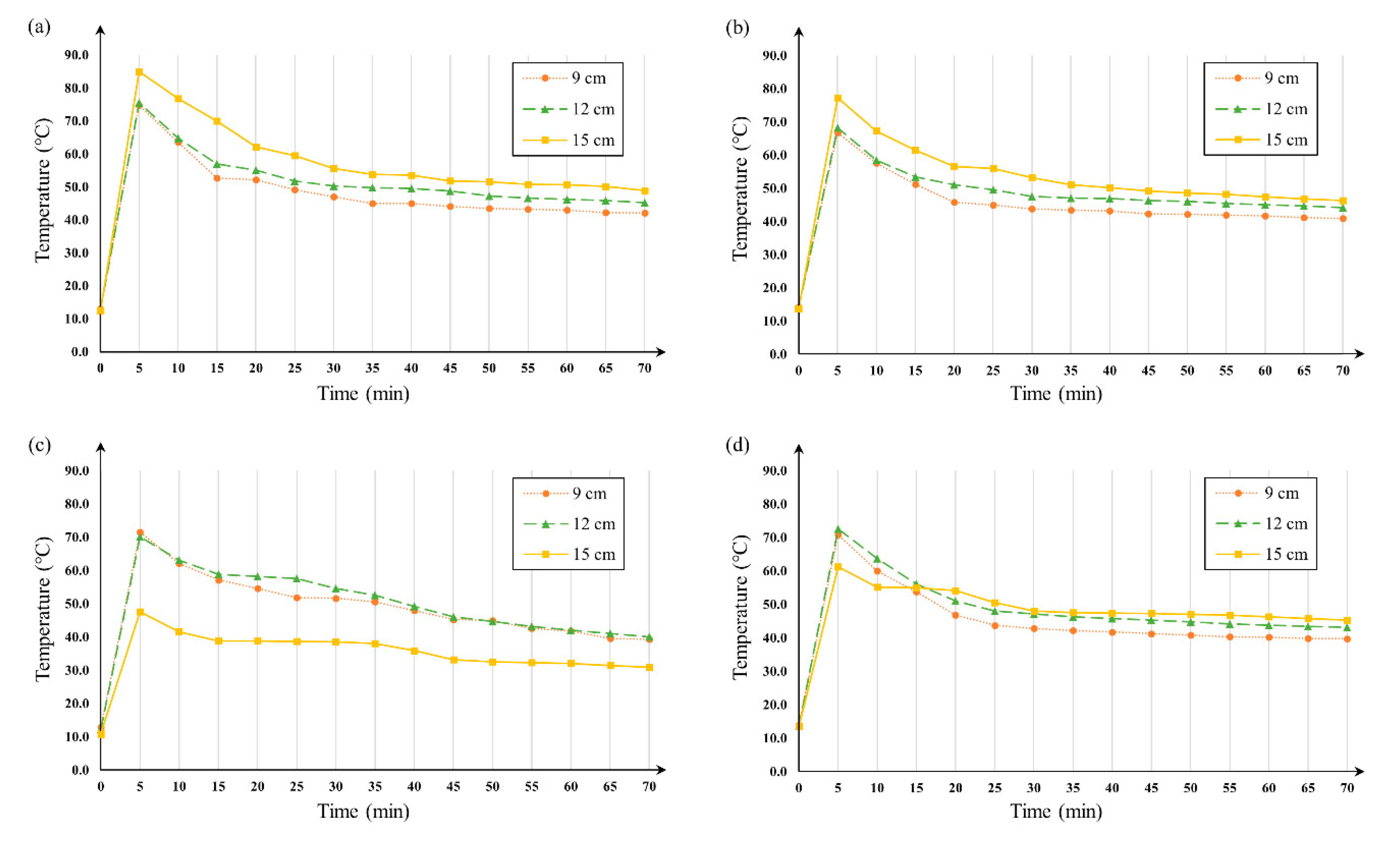
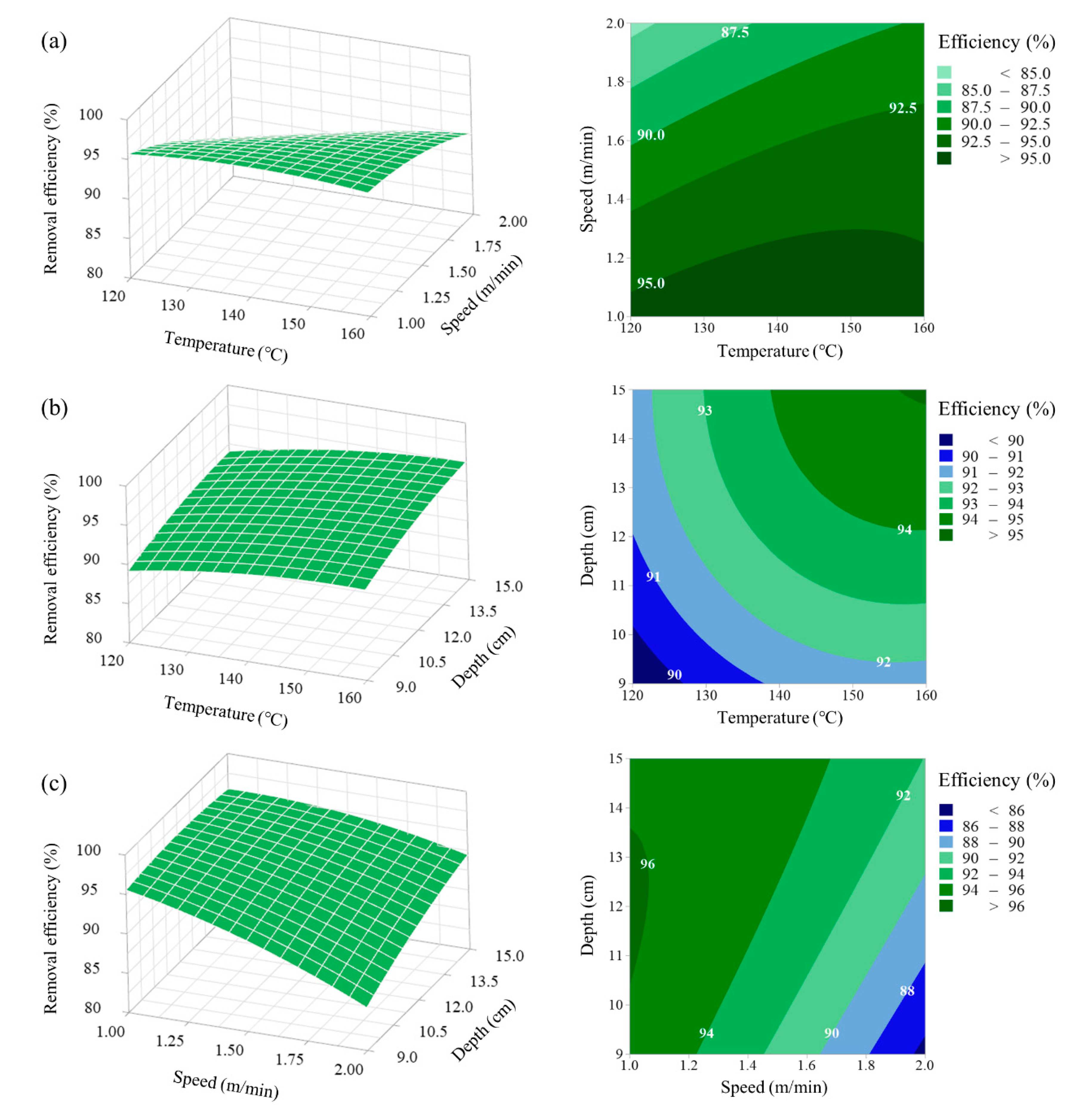

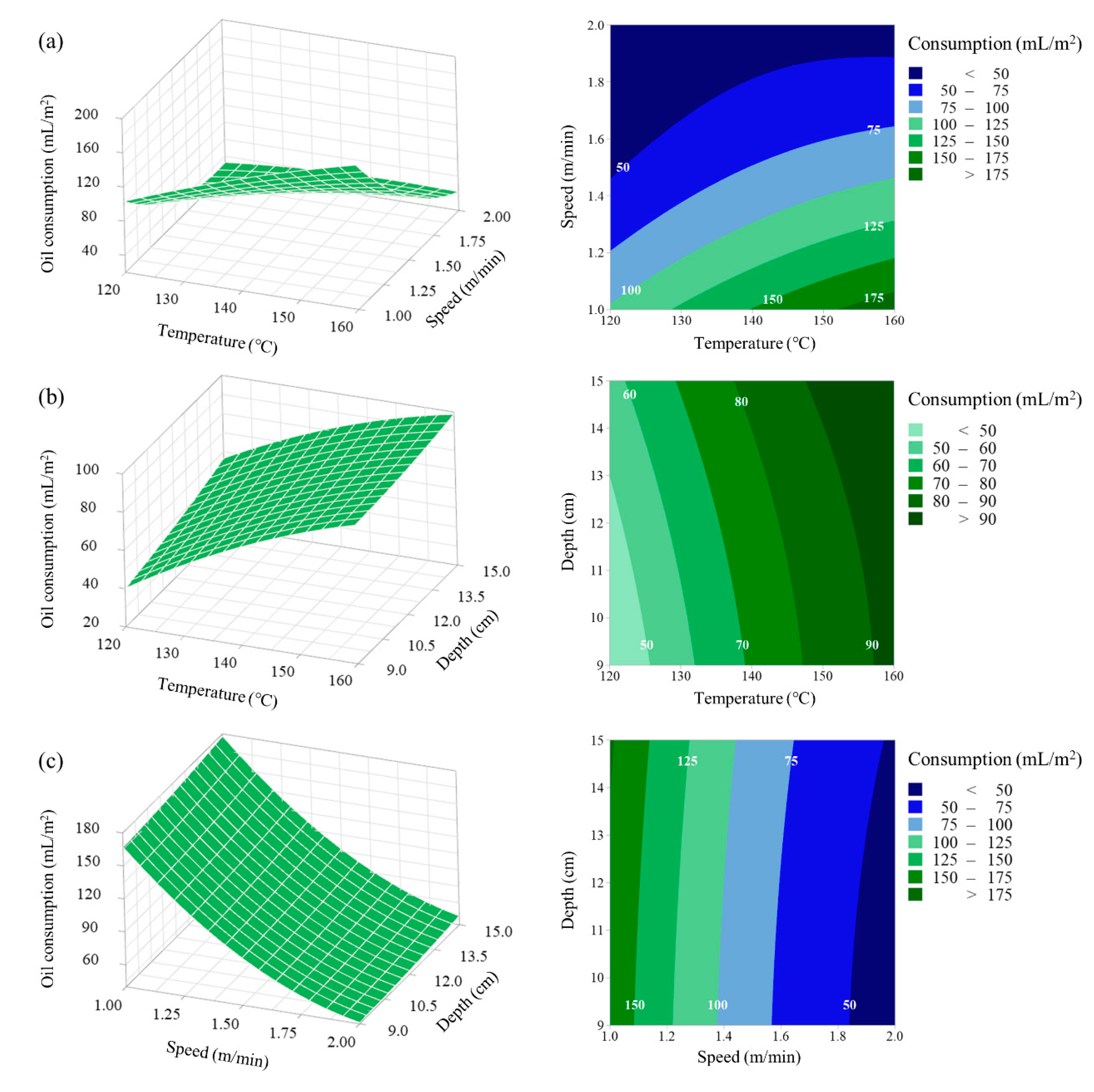
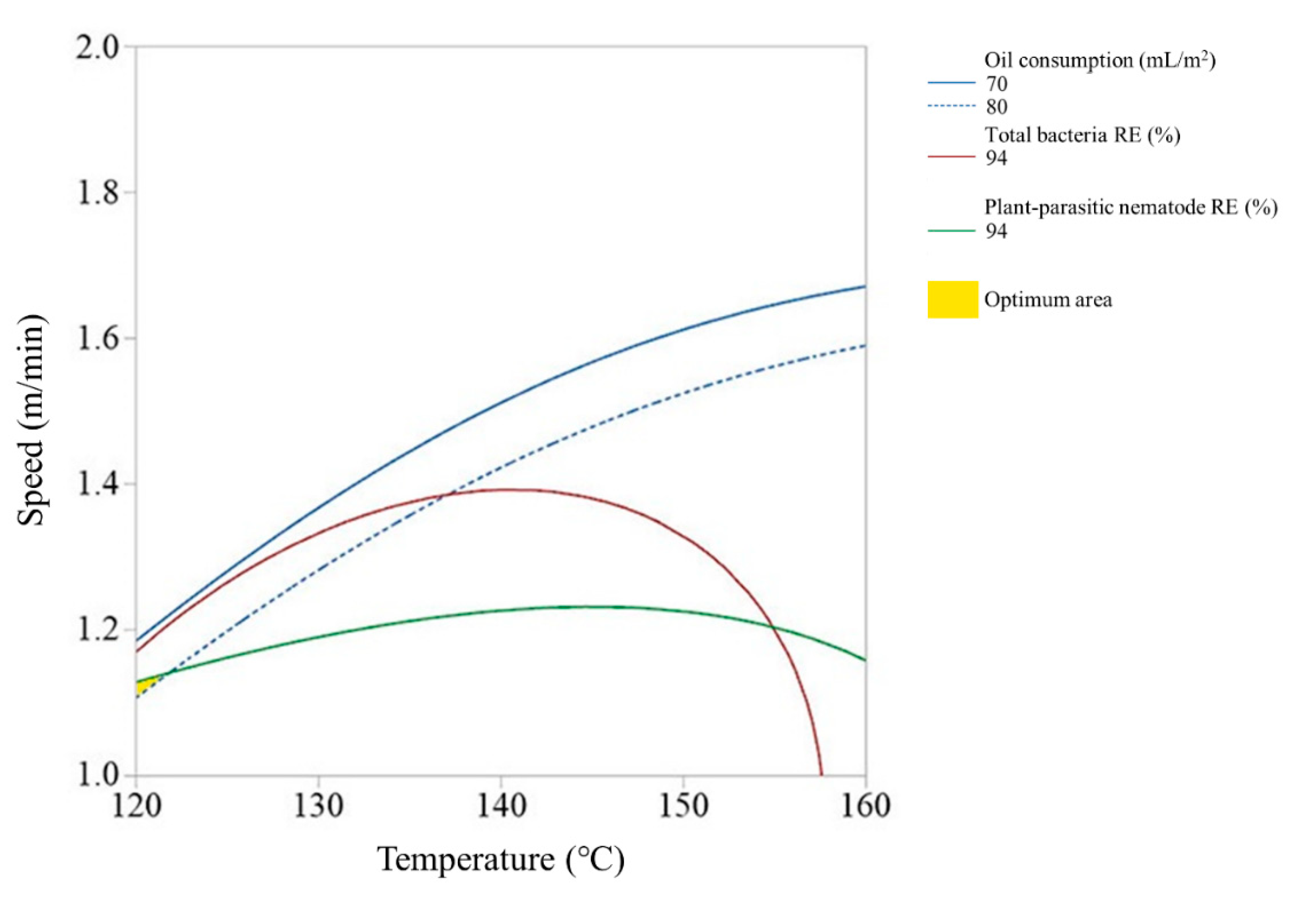
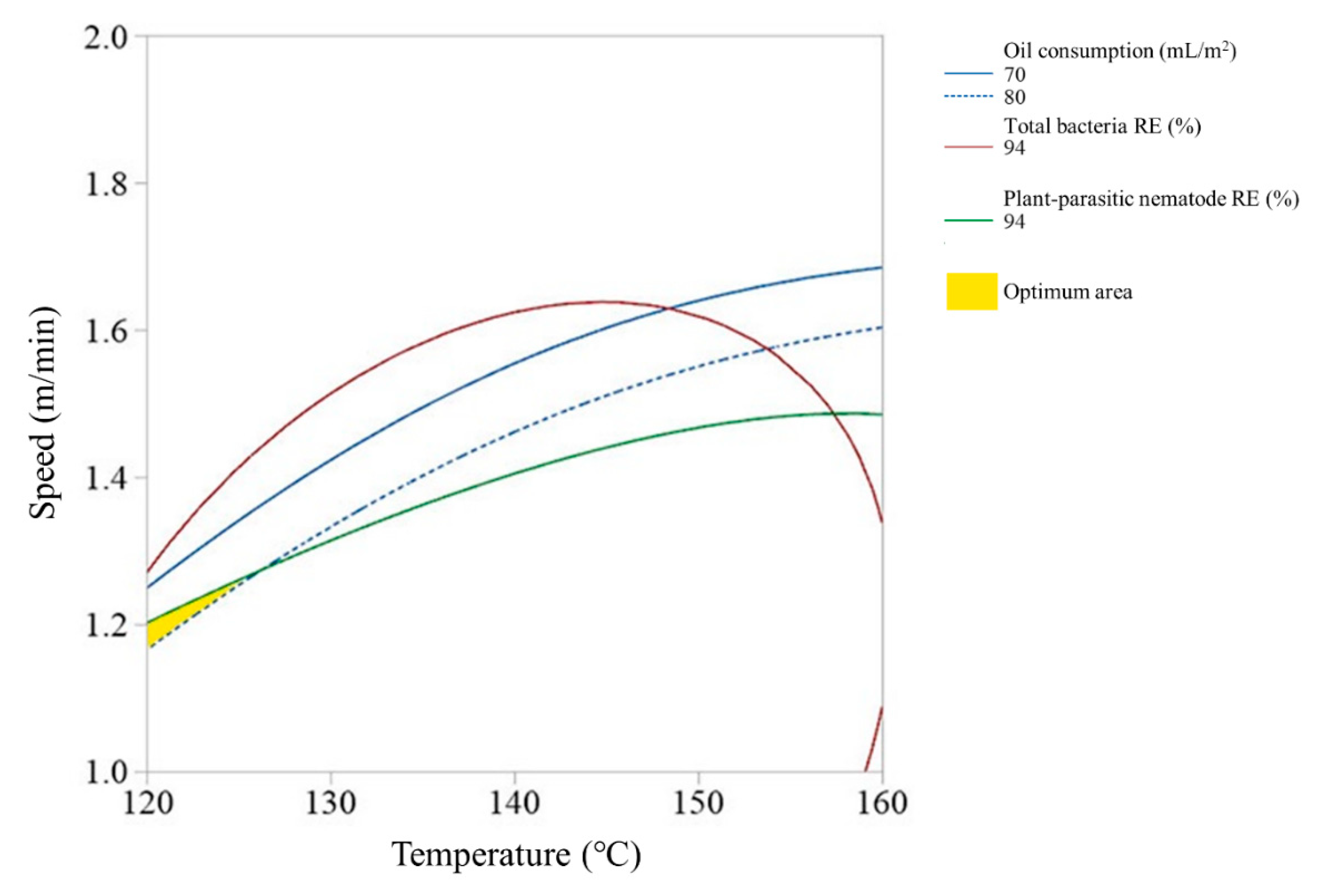
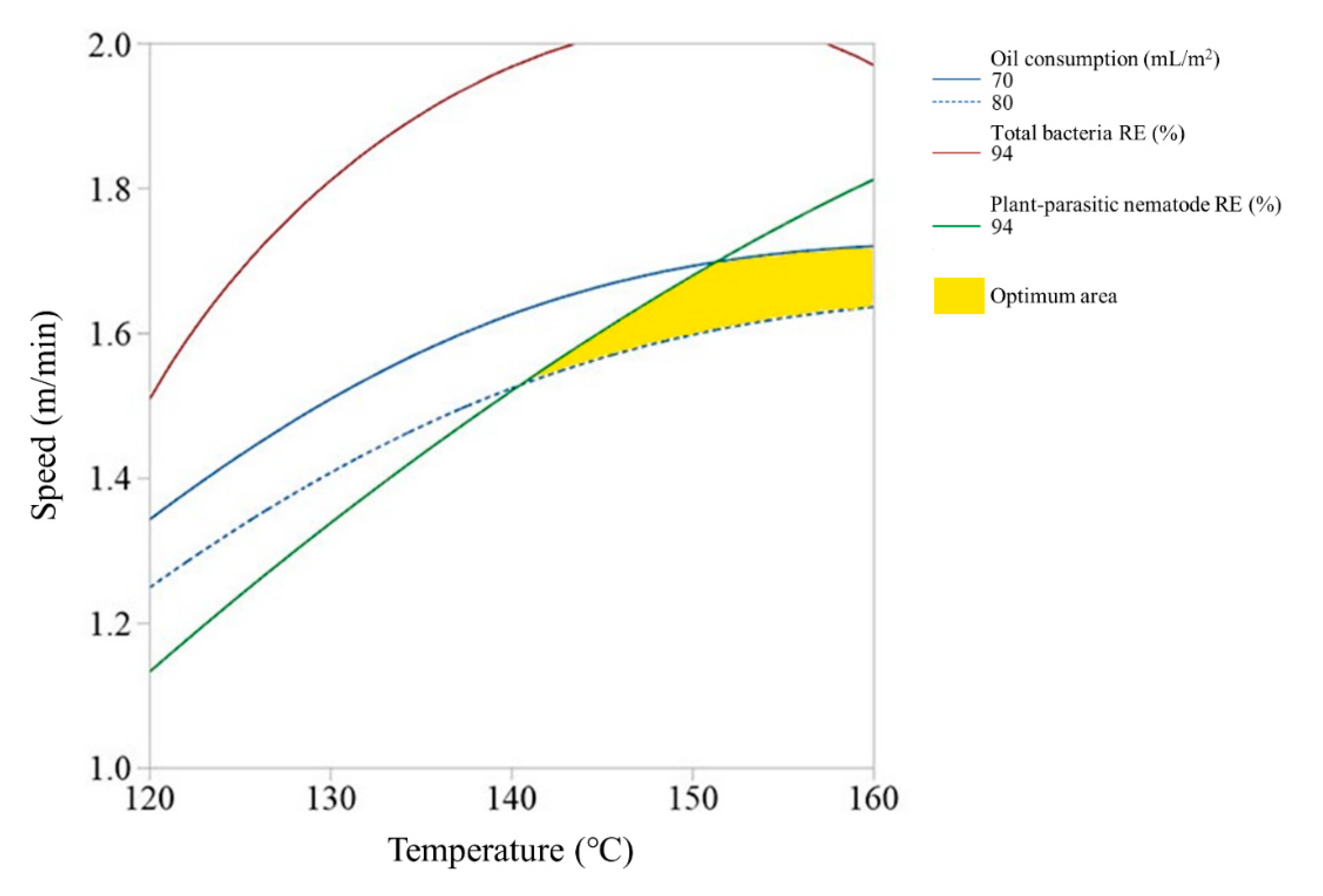
| Variables | Symbols | Uncoded Levels | ||
|---|---|---|---|---|
| −1 | 0 | 1 | ||
| Steam temperature (°C) | 120 | 140 | 160 | |
| Running speed (m/min) | 1.0 | 1.5 | 2.0 | |
| Spray depth (cm) | 9 | 12 | 15 | |
| Run No. | Coded Levels of Explanatory Variables | Uncoded Levels of Explanatory Variables | Response Variables | ||||||
|---|---|---|---|---|---|---|---|---|---|
| Nematode RE † (%) | Total Bacteria RE † (%) | Oil Consumption (mL/m2) | |||||||
| 1 | 0 | −1 | −1 | 140 | 1.0 | 9 | 94.42 | 96.56 | 145 |
| 2 | 0 | 1 | −1 | 140 | 2.0 | 9 | 84.80 | 83.10 | 40 |
| 3 | 0 | 0 | 0 | 140 | 1.5 | 12 | 92.09 | 95.64 | 71 |
| 4 | 1 | 1 | 0 | 160 | 2.0 | 12 | 89.90 | 86.22 | 42 |
| 5 | −1 | 0 | 1 | 120 | 1.5 | 15 | 91.77 | 94.30 | 58 |
| 6 | 1 | 0 | −1 | 160 | 1.5 | 9 | 91.34 | 89.67 | 91 |
| 7 | 1 | −1 | 0 | 160 | 1.0 | 12 | 97.25 | 94.95 | 191 |
| 8 | 0 | −1 | 1 | 140 | 1.0 | 15 | 95.12 | 96.71 | 158 |
| 9 | 1 | 0 | 1 | 160 | 1.5 | 15 | 93.89 | 96.83 | 98 |
| 10 | 0 | 0 | 0 | 140 | 1.5 | 12 | 93.64 | 96.12 | 75 |
| 11 | −1 | −1 | 0 | 120 | 1.0 | 12 | 95.95 | 96.81 | 103 |
| 12 | 0 | 0 | 0 | 140 | 1.5 | 12 | 93.99 | 94.55 | 81 |
| 13 | −1 | 1 | 0 | 120 | 2.0 | 12 | 82.56 | 80.23 | 31 |
| 14 | 0 | 1 | 1 | 140 | 2.0 | 15 | 92.01 | 94.58 | 49 |
| 15 | −1 | 0 | −1 | 120 | 1.5 | 9 | 90.29 | 88.55 | 41 |
| Sources | Nematode Removal Efficiency | Total Bacteria Removal Efficiency | Oil Consumption | |||||||||
|---|---|---|---|---|---|---|---|---|---|---|---|---|
| -Value | -Value | -Value | ||||||||||
| Model | 0.022 | 0.9279 | 0.7982 | 0.003 | 0.9678 | 0.9097 | <0.001 | 0.9979 | 0.9941 | |||
| Lack-of-fit | 0.189 | 0.142 | 0.876 | |||||||||
| Constants | 90.0 | <0.001 | −1.2 | <0.001 | −469 | <0.001 | ||||||
| 0.350 | 0.568 | 1.883 | 0.088 | 8.04 | <0.001 | |||||||
| −30.2 | 0.007 | −27.5 | 0.002 | −83.8 | <0.001 | |||||||
| −0.09 | 0.087 | −2.75 | 0.006 | 5.31 | 0.037 | |||||||
| −0.00199 | 0.428 | −0.00786 | 0.014 | −0.01240 | 0.049 | |||||||
| −4.12 | 0.315 | −10.97 | 0.023 | 84.17 | <0.001 | |||||||
| −0.069 | 0.529 | 0.0048 | 0.962 | 0.144 | 0.529 | |||||||
| 0.1510 | 0.149 | 0.1962 | 0.061 | −1.925 | <0.001 | |||||||
| 0.0045 | 0.775 | 0.0059 | 0.684 | −0.0417 | 0.231 | |||||||
| 1.085 | 0.126 | 1.888 | 0.018 | −0.67 | 0.609 | |||||||
| Variables | Optimal Conditions | Predicted Responses | ||||
|---|---|---|---|---|---|---|
| Steam Temperature (°C) | Running Speed (m/min) | Spray Depth (cm) | Nematode RE † (%) | Bacteria RE † (%) | Oil Consumption (mL/m2) | |
| Values | 150.56 | 1.69 | 15.0 | 93.99 | 97.49 | 70.49 |
© 2020 by the authors. Licensee MDPI, Basel, Switzerland. This article is an open access article distributed under the terms and conditions of the Creative Commons Attribution (CC BY) license (http://creativecommons.org/licenses/by/4.0/).
Share and Cite
Huh, D.-A.; Chae, W.R.; Lim, H.L.; Kim, J.H.; Kim, Y.S.; Kim, Y.-W.; Moon, K.W. Optimizing Operating Parameters of High-Temperature Steam for Disinfecting Total Nematodes and Bacteria in Soil: Application of the Box−Behnken Design. Int. J. Environ. Res. Public Health 2020, 17, 5029. https://doi.org/10.3390/ijerph17145029
Huh D-A, Chae WR, Lim HL, Kim JH, Kim YS, Kim Y-W, Moon KW. Optimizing Operating Parameters of High-Temperature Steam for Disinfecting Total Nematodes and Bacteria in Soil: Application of the Box−Behnken Design. International Journal of Environmental Research and Public Health. 2020; 17(14):5029. https://doi.org/10.3390/ijerph17145029
Chicago/Turabian StyleHuh, Da-An, Woo Ri Chae, Hong Lyuer Lim, Joung Ho Kim, Yoo Sin Kim, Young-Whan Kim, and Kyong Whan Moon. 2020. "Optimizing Operating Parameters of High-Temperature Steam for Disinfecting Total Nematodes and Bacteria in Soil: Application of the Box−Behnken Design" International Journal of Environmental Research and Public Health 17, no. 14: 5029. https://doi.org/10.3390/ijerph17145029
APA StyleHuh, D.-A., Chae, W. R., Lim, H. L., Kim, J. H., Kim, Y. S., Kim, Y.-W., & Moon, K. W. (2020). Optimizing Operating Parameters of High-Temperature Steam for Disinfecting Total Nematodes and Bacteria in Soil: Application of the Box−Behnken Design. International Journal of Environmental Research and Public Health, 17(14), 5029. https://doi.org/10.3390/ijerph17145029




